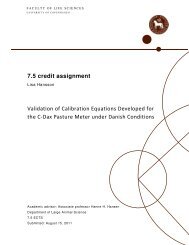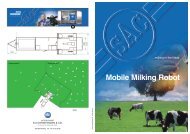Innovative Technology and Sustainable Development of Organic - 1.
Innovative Technology and Sustainable Development of Organic - 1.
Innovative Technology and Sustainable Development of Organic - 1.
You also want an ePaper? Increase the reach of your titles
YUMPU automatically turns print PDFs into web optimized ePapers that Google loves.
premium price for organic milk. The time saving <strong>of</strong> between 27 <strong>and</strong> 70% (Rasmussen, 2000) by using<br />
AMS also is for the organic farmer hard to capitalize. Combining AMS <strong>and</strong> grazing might even result<br />
in additional work, such as having to fetch the cows, rather than them coming voluntarily (Van Dooren<br />
et al., 2003). The dem<strong>and</strong> for grazing could result also in a decrease in milking frequency, affecting<br />
the expected annual milk yield increase (Ketelaar-de Lauwere et al., 2000).<br />
The data show that organic dairy farms in general have a better financial income than their<br />
conventional colleagues (Water, 2002; Nielsen <strong>and</strong> Vestergaard, 2003; Jørgensen <strong>and</strong> Pedersen, 2004).<br />
This could decrease the risk <strong>of</strong> large expenses when investing. However, judging from the experience<br />
<strong>of</strong> conventional AMS farms <strong>and</strong> the presumed consequences for the organic herds, no large economic<br />
gain is expected for organic farms using AMS compared to non AMS organic farms.<br />
Ecological Issues<br />
The environmental impact <strong>of</strong> AMS use can be assessed by estimating its effect on the use <strong>of</strong> natural<br />
resources such as water <strong>and</strong> fossil energy, <strong>and</strong> its effect on eutrophication, climate change,<br />
acidification, <strong>and</strong> biodiversity (Audsley et al., 1997; de Boer, 2003). From the literature review based<br />
on conventional farms only (Oudshoorn <strong>and</strong> de Boer, 2005), it can be concluded that water <strong>and</strong> fossil<br />
energy use is higher for farms with AMS. This is not expected to be different for the organic farms.<br />
Eutrophication especially with nitrogen, <strong>and</strong> possibly phosphorous, due to high stocking rates<br />
caused by intensive grazing <strong>of</strong> farmstead lots, could be a problem for farms with AMS compared to<br />
farms without. This is especially true for organic farms, for which grazing is obligatory.<br />
Global warming due to emission <strong>of</strong> carbon dioxide (CO2), methane (CH4), <strong>and</strong> nitrous oxide (N2O)<br />
is estimated not to be affected substantially by AMS use, neither for organic nor for conventional<br />
dairy. The increase in CO2 emission from the increase in fossil energy use is expected to be<br />
compensated by a higher milk yield per cow, which decreases methane production per unit milk (de<br />
Boer, 2003). This is not expected to differ for organic practices. The emission <strong>of</strong> N2O, which is<br />
directly related to the amount <strong>of</strong> N applied on the field, is not expected to be different for organic<br />
farms with <strong>and</strong> without AMS. Similarly, the emission <strong>of</strong> ammonia (NH3) causing acidification, from<br />
animal manure in stable, in storage facilities, during grazing <strong>and</strong> application <strong>of</strong> manure is not expected<br />
to change by AMS use. Biodiversity <strong>of</strong> l<strong>and</strong>scape <strong>and</strong> pasture flora( Noe et al., 2005) are expected to<br />
be affected by AMS use as a result <strong>of</strong> a change in the pasturing system, i.e., less grazing <strong>and</strong> more<br />
mowing.<br />
Societal Issues<br />
On-farm societal issues affected by AMS use comprise animal health <strong>and</strong> welfare, milk quality, <strong>and</strong><br />
the farmer’s satisfaction, partially based on labour circumstances. The impact <strong>of</strong> AMS use on these<br />
issues is not always quantifiable <strong>and</strong> is subject to attitudes <strong>and</strong> reflections (ethical, pragmatic,<br />
impulsive). From the literature review (Oudshoorn <strong>and</strong> de Boer, 2005) it can be concluded that some<br />
health parameters <strong>and</strong> welfare <strong>of</strong> dairy cows is influenced negatively when grazing is reduced (Somers<br />
et al. 2003). Recent investigation showed that AMS use on organic dairy farms reduced grazing time<br />
(Kramer, 2006; Hoeksma, 2005), just as on conventional dairy farms (Mathijs, 2004). EU regulations<br />
enforce grazing, but do not specify exactly how much. AMS use affects milk quality directly through<br />
an increase in Free Fatty Acid (FFA) content, <strong>and</strong> indirectly (vitamins, carotene, <strong>and</strong> fatty acid pr<strong>of</strong>ile)<br />
through a reduction <strong>of</strong> the intake <strong>of</strong> fresh grass resulting from a reduction in grazing time. Farmers<br />
generally are very satisfied with their gain <strong>of</strong> free time. Technical dependency <strong>of</strong> the farmer <strong>and</strong><br />
Thesis Frank W. Oudshoorn 23




